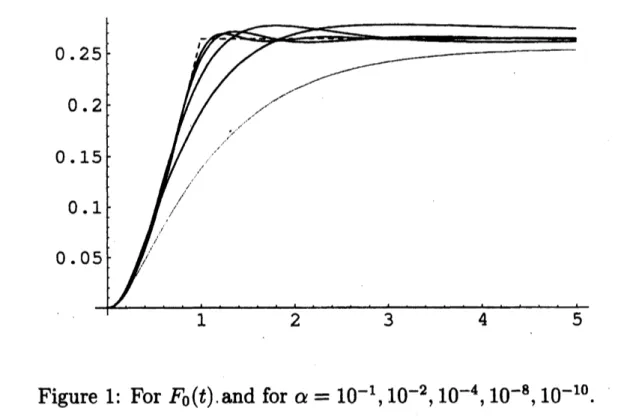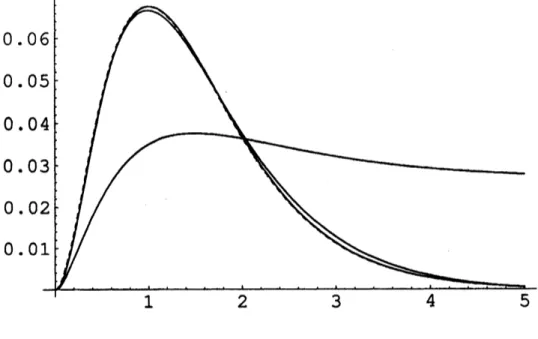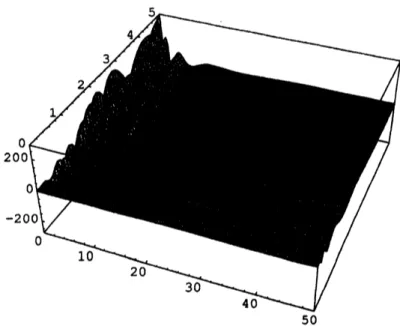Numerical Real Inversion Formulas of the
Laplace
Transform
by
using
a
Fredholm
integral
equation
of
the
second
kind
T.
Matsuura
(
松浦勉
)
Graduate
School of
Mechanical
Engineering,
Gunma
University, Kiryu,
376-8515,
Japan
E-mail:
matsuura@me.gunma-u.ac.jp
Abdulaziz Al-Shuaibi
KFUPM
Box 449, Dhahran 31261, Saudi Arabia
E-mail:
shuaaziz@kfupm.edu.sa
H. Fujiwara (
藤原宏志
)
Graduate
School of
Informatics,
Kyoto University,
Japan
E-mail:
fujiwara@acs.i.kyoto-u.ac.jp
and S. Saitoh
(
齋藤三郎
)
Graduate
School
of
Engineering,
Gunma
University, Kiryu,
376-8515,
Japan
E-mail:
ssaitoh@math.sci.gunma-u.ac.jp
1
Introduction
We shall give
a
very natural and numerical real inversion formula of the Laplace transformfor functions $F$ of
some
natural function space. This integral transform is,of course, very fundamental in mathematical science. The inversion of the Laplace transform is, in general, given by a complex form, however, we
are
interested in and
are
requested to obtain its real inversion in many practical problems. However, the real inversion will be very involved andone
mightthink that its real inversion will be essentially involved, because
we
must catch “analyticity” from the realor
discrete data. Note that the image functions of the Laplace transformare
analytic onsome
half complex plane. For complexity of the real inversion formula of the Laplace transform,we
recall, for example, the following formulas:
$\lim_{narrow\infty}\frac{(-1)^{n}}{n!}(\frac{n}{t})^{n+1}f^{(n)}(\frac{n}{t})=F(t)$ (Post [15] and Widder [25,26]), and
$\lim_{narrow\infty}\Pi_{k=1}^{n}(1+\frac{t}{k}\frac{d}{dt})[\frac{n}{t}f(\frac{n}{t})]=F(t)$
,
([25,26]). FUrthermore,
see
[1-7,10,11,17,18,21] and the recent related articles [10] and 11]. See also the great references $[27,28]$.
The problem may berelated to analytic extension problems,
see
[10] and [11].In this paper,
we
shall givenew
type and very natural real inversion formulas from the viewpoints of best approximations, generalized inverses and the Tikhonov regularization by combining these fundamental ideas and methods bymeans
of the theory of reproducing kernels. However, in thispaper we shall propose
a new
method for the real inversion formulas of the Laplace transform based essentiallyon
a
Fredholm integral equation of the second kind. We may think that these real inversion formulasare
practical and natural. Wecan
give gooderror
estimates inour
inversion formulas.EUrthermore,
we
shall illustrate examples, by using computers.2
Background General Theorems
Let $E$ be
an
arbitrary set, and let $H_{K}$ bea
reproducing kernel Hilbert space (RKHS) admitting the reproducing kernel $K(p,q)$on
$E$.
For any Hilbertgenerally interested in the best approximate problem
$\inf_{f\in K}\Vert Lf-d||_{\mathcal{H}}$ (2.2)
for a vector $d$ in $\mathcal{H}$
.
However, when there exits, this extremal problem isinvolved in the both
senses
ofthe existence of the extremal functions in (2.2)and their representations. See [16] for the details. So,
we
shall consider itsTikhonov regularization.
We set, for any fixed positive $\alpha>0$
$K_{L}( \cdot,p;\alpha)=\frac{1}{L^{*}L+\alpha I}K(\cdot,p)$,
where $L^{*}$ denotes the adjoint operator of $L$
.
Then, by introducing the innerproduct
$(f,g)_{H_{K}(L;\alpha)}=\alpha(f,g)_{H_{K}}+(Lf,Lg)_{\mathcal{H}}$, (2.3)
we
shall construct the Hilbert space $H_{K}(L;\alpha)$ comprising functions of $H_{K}$.
This
space,
of course, admitsa
reproducing kernel. Furthermore,we
obtain, directlyProposition 2.1 ([J8]) The extremal
function
$f_{d,\alpha}(p)$ in the Tikhonovoeg-ulanzation
$\inf_{f\in H_{K}}\{\alpha||f||_{H_{K}}^{2}+\Vert d-Lf||_{\mathcal{H}}^{2}\}$ (2.4)
exists uniquely and it is represented in $te$rms
of
the kemel $K_{L}(p, q;\alpha)$ asfollows:
$f_{d,\alpha}(p)=(d,LK_{L}(\cdot,p;\alpha))_{\mathcal{H}}$ (2.5)
where the kemel $K_{L}(p, q;\alpha)i_{8}$ the reproducing kemel
for
the Hilbert space $H_{K}(L;\alpha)$ and it is determinedas
the unique solution $\tilde{K}(p, q;\alpha)$of
theequa-tion:
$\tilde{K}(p, q;\alpha)+\frac{1}{\alpha}(L\tilde{K}_{q}, LK_{p})_{\mathcal{H}}=\frac{1}{\alpha}K(p, q)$ (2.6)
with
$\tilde{K}_{q}=\tilde{K}(\cdot, q;\alpha)\in H_{K}$
for
$q\in E$, (2.7)and
In (2.5), when $d$ contains errors or noises, we need its
error
estimate. Forthis,
we can
obtain the general result:Proposition 2.2 (/14]). In (2.5),
we
have the estimate$|f_{d,\alpha}(p)| \leq\frac{1}{\sqrt{\alpha}}\sqrt{K(p,p)}||d\Vert_{\mathcal{H}}$
.
For the convergence rate
or
the results for noisy data, see, ([9]).3
A
Natural
Situation for
Real
Inversion
For-mulas
In order toapply the general theory in Section 2 to the real inversion formula of the Lapace transform,
we
shall recall the “natural situation” basedon
$[17,13]$
.
We shall introduce the simple reproducing kernel Hilbert space (RKHS) $H_{K}$ comprised of absolutely continuous functions $F$ on the positive real line $R^{+}$ with finite
norms
$\{\int_{0}^{\infty}|F’(t)|^{2}\frac{1}{t}e^{t}dt\}^{1/2}$
and satisfying $F(O)=0$
.
This Hilbert space admits the reproducing kernel$K(t,t’)$
$K(t,t’)= \int_{0}^{\min(t,t’)}\xi e^{-\xi}d\xi$ (3.8)
(see [9], pages 55-56). Then we
see
that$\int_{0}^{\infty}|(\mathcal{L}F)(p)p|^{2}dp\leq\frac{1}{2}||F\Vert_{H_{K}}^{2}$ ; (3.9)
that is, the linear operator
on
$H_{K}$$(\mathcal{L}F)(p)p$
into $L_{2}(R^{+}, dp)=L_{2}(R^{+})$ is bounded ([17]). For the reproducing kemel
Hilbert spaces $H_{K}$ satisfying (3.9),
we can
findsome
general spaces ([17]). Therefore, from the general theory in Section 2, we obtainProposition 3.1 ([1?]). For any $g\in L_{2}(R^{+})$ and
for
any $\alpha>0$, the be8tapproximation $F_{\alpha,g}^{*}$ in the
sense
$\inf_{F\in H_{K}}\{\alpha\int_{0}^{\infty}|F’(t)|^{2}\frac{1}{t}e^{t}dt+\Vert(\mathcal{L}F)(p)p-g||_{L_{2}(R+}^{2})\}$
$= \alpha\int_{0}^{\infty}|F_{\alpha,g}^{*\prime}(t)|^{2}\frac{1}{t}e^{t}dt+||(\mathcal{L}F_{\mathfrak{a},g}^{*})(p)p-g||_{L_{2}(R+}^{2})$ (3.10)
exists uniquely and
we
obtain the representation$F_{\alpha,g}^{*}(t)= \int_{0}^{\infty}g(\xi)(\mathcal{L}K_{\alpha}(\cdot, t))(\xi)\xi d\xi$
.
(3.11)Here, $K_{\alpha}(\cdot,t)$ is determined by the
functional
equation$K_{\alpha}(t,t’)= \frac{1}{\alpha}K(t,t’)-\frac{1}{\alpha}((\mathcal{L}K_{\alpha,t’})(p)p, (\mathcal{L}K_{t})(p)p)_{L_{2}(R+})$ (3.12)
for
$K_{\alpha,t’}=K_{\alpha}(\cdot, t’)$
and
$K_{t}=K(\cdot,t)$
4
New
Algorithm
We shall look for the approximate inversion $F_{\alpha,g}^{*}(t)$ by using (3.11). For this
purpose,
we
takethe Laplacetransform of(3.12) in$t$ and change the variables $t$ and $t$as
in$(\mathcal{L}K_{\alpha}(\cdot, t))(\xi)$
$= \frac{1}{\alpha}(\mathcal{L}K(\cdot,t’))(\xi)-\frac{1}{\alpha}((\mathcal{L}K_{\alpha,t’})(p)p, (\mathcal{L}(\mathcal{L}K_{t})(p)p))(\xi))_{L_{2}(R+})$
.
(4.13)Note that
$(\mathcal{L}K(\cdot,t’))(p)$
$=e^{-t’p}e^{-t’}[ \frac{-t’}{p(p+1)}+\frac{-1}{p(p+1)^{2}}]+\frac{1}{p(p+1)^{2}}$
.
(4.14)$\int_{0}^{\infty}e^{-qt’}(\mathcal{L}K(\cdot, t’))(p)dt’=\frac{1}{pq(p+q+1)^{2}}$ (4.15)
Therefore, by setting
$(\mathcal{L}K_{\alpha}(\cdot,t))(\xi)\xi=H_{\alpha}(\xi,t)$,
which is needed in (3.11), we obtain the Fredholm integral equation of the second type
$\alpha H_{a}(\xi, t)+\int_{0}^{\infty}H_{\alpha}(p, t)\frac{1}{(p+\xi+1)^{2}}dp$
$=- \frac{e^{-t\xi}e^{-t}}{\xi+1}(t+\frac{1}{\xi+1})+\frac{1}{(\xi+1)^{2}}$
.
(4.16)5
Numerical Experiments
We shall give a numerical experiment for the typical example $F_{0}(t)=\{\begin{array}{ll}\text{一} te^{-t}-e^{-t}+1 for 0\leq t\leq 11-2e^{-1} for 1\leq t,\end{array}$
whose Laplace transform is
$( \mathcal{L}F_{0})(p)=\frac{1}{p(p+1)^{2}}[1-(p+2)e^{-(p+1)}]$
.
(5.17)We set
$g(\xi)=(\mathcal{L}F_{0})(\xi)\xi$
in (3.11) with $(\mathcal{L}K_{\alpha}(\cdot, t))(\xi)\xi=H_{\alpha}(\xi, t)$, then
$F_{\alpha,g}^{*}(t)\sim F_{0}(t)$
For fixed $t$,
we
calculate the integral (4.16)over
$[0,50]$ with span0.01
bythe trapezoidal rule. Here
we
solve the linear simultaneous linear equationsof 5000 by using Matlab. For $t$,
we
take the valuesover
$[0,5]$ with span 0.01.By (3.11),
we
caluculate the inversion by the trapeziodal ruleover
$[0,50]$ withthe span
0.01.
Figure 1: For $F_{0}(t)$.and for $\alpha=10^{-1}$, $10^{-2}$
’ $10^{-4}$’ $10^{-8},10^{-10}$
.
Acknowledgements
Al-Shuaibi visiting Gunma University was supported by the Japan
Coop-eration Center, Petroleum, the Japan Petroleum Institute (JPI) and King Fahd University of Petroleum and Minerals, and he wishes to express his
deep thanks Professor Saburou Saitoh and Mr. Hideki Konishi of the JPI for their kind hospitality. S. Saitoh is supported in part by the Grant-in-Aid for Scientific Research (C)(2)(No. 16540137) from the Japan Society for the Promotion
Science. S.
Saitoh and T. Matsuuraare
partially supported by the Mitsubishi Foundation, the 36th, Natural Sciences, No. 20 (2005-2006).References
[1] Abdulaziz Al-Shuaibi, On the inversion
of
the Laplacetransfom
by $u8e$of
a
regularized di8placement operator, Inverse Problems 13(1997),Figure 2: For $F(t)=\chi(t, [1/2,3/2])$, the characteristic function and for
$\alpha=10^{-1},10^{-4},10^{-8},10^{-12},10^{-16}$
.
$( \mathcal{L}F)(p)=\frac{1}{p}(\exp(-\frac{1}{2}p)-\exp(-\frac{3}{2}p))$.
Figure 3: For $U(t, [1, \infty])$, the step function and for $\alpha$ $=$
Figure 4: For $F(t)=1/2t^{2}\exp(-2t)$ and for $\alpha=10^{-1},10^{-4},10^{-8}$
.
$(\mathcal{L}F)(p)=$$\frac{1}{(p+2)^{3}}$
Figure 6: For $H_{\alpha}(\xi, t)$ and for $\alpha=10^{-8}$
.
[2] Abdulaziz Al-Shuaibi, The Riemann zeta
function
used in the inversionof
the Laplace transform, Inverse Problems 14(1998), 1-7.[3] Abdulaziz Al-Shuaibi, Inversion
of
the Laplacetransform
via Post-Widder formula, Integral Transforms and Special IFMnctions 11(2001),225-232.
[4] K. Amano, S. Saitoh and A. Syarif, A Real Inversion Formula
for
theLaplace $\pi_{ansform}$ in a Sobolev Space, Z. Anal. Anw. 18(1999),
1031-1038.
[5] K. Amano, S. Saitohand M. Yamamoto, Error estimates
of
the realinver-sion
fomulas
of
the Laplace tmnsform, Integral Transforms and SpecialIFMnctions, 10 (2000),
165-178.
[6] A. Boumenir and A. Al-Shuaibi, The Inverse Laplace
transfo
$7vn$ andAn-alyti$c$
Pseudo-Differential
Opemtors, J. Math. Anal. Appl. 228(1998),16-36.
[7] D.-W. Byun and S. Saitoh, A real inversion
formula
for
the Laplace[8] G. Doetsch, Handbuch der Laplace $\mathcal{I}kansformation$, Vol. 1., Birkhaeuser Verlag, Basel,
1950.
[9] H. W. Engl, M. Hanke and A. Neubauer, Regularization ofInverse
Prob-lems, Mathematics and Its Applications 376(2000), Kluwer Academic Publishers.
[10] V. V. Kryzhniy, Regulanized Inversion
of
Integral $\pi_{a}$nsformations of
Mellin Convolution $X\mathfrak{y}pe$, Inverse Problems, 19(2003),
1227-1240.
[11] V. V. Kryzhniy, Numerecal inversion
of
the Laplacetransfom:
analysis via regulanzed analytic continuation, Inverse Problems, 22 (2006),579-597.
[12] T. Matsuura and S. Saitoh, Analytical and numerical solutions
of
lin-ear
ordinarydifferential
equations with constant coefficients, Journal ofAnalysis and Applications, 3(2005), pp. 1-17.
[13] T. Matsuura and S. Saitoh, Analytical and numerical real inversion
for-mulas
of
the Laplace transform, The ISAAC Catani Congress Proceedings(to appear).
[14] T. Matsuura
and S.
Saitoh,Analytical
and numerical inversionformulas
in theGaussian convolution
by using the Paley- Wiener spaces, Applicable Analysis, 85(2006),901-915.
[15] E. L. Post, Generalized diffentiation, bans. Amer. Math. Soc. 32(1930),
723-781.
[16] S. Saitoh, Integral $I$}$u$nsforms, Reproducing Kemels and their Applica-tions, Pitman Res. Notes in Math. Series 369, Addison Wesley Longman
Ltd (1997), UK.
[17] S. Saitoh, Approximate real inversion
formula8 of
the Laplace transform, Far East J. Math.Sci.
11(2003),53-64.
[18] S. Saitoh, Approvzmate Real Inversion Formulas
of
the GaussianCon-volution, Applicable Analysis, 83(2004), 727-733.
[19] S. Saitoh, Best approvimation, Tikhonov regularization and reproducing
[20] S. Saitoh, Tikhonov regularization and the theory
of
reproducing kemels,Proceedings of the 12th International Conference
on
Finiteor
InfiniteDimensional Complex Analysis and Applications, Kyushyu University
Press (2005), 291-298.
[21] S. Saitoh, Vu Kim Tuan and M. Yamamoto, Conditional Stability
of
a Real Inverse Formulafor
the Laplace $\pi_{ansform}$, Z. Anal. Anw. 20(2001),193-202.
[22] S. Saitoh, N. Hayashi and M. Yamamoto (eds.), Analytic Extension For-mulas and their Applications, (2001), Kluwer Academic Publishers.
[23] Vu Kim Tuan and Dinh Thanh Duc, Convergence rate
of
Post- Widderapproximate inversion
of
the Laplace transform, Vietnam J. Math. 28(2000),93-96.
[24] Vu Kim Tuan and Dinh Thanh Duc, A
new
real inversionformula for
the Laplacetransform
and its convergence $mte$, Rac. Cal.&Appl.
Anal.5(2002),
387-394.
[25] D. V. Widder, The inversion
of
the Laplace integral and the related moment problem, ?kans. Amer. Math. Soc. 36(1934), 107-2000.[26] D. V. Widder, The Laplace Transform, Princeton University Press, Princeton,
1972.
[27] $http://library$

![Figure 2: For $F(t)=\chi(t, [1/2,3/2])$ , the characteristic function and for](https://thumb-ap.123doks.com/thumbv2/123deta/5996841.1061677/8.892.181.733.143.493/figure-f-t-chi-t-characteristic-function.webp)

